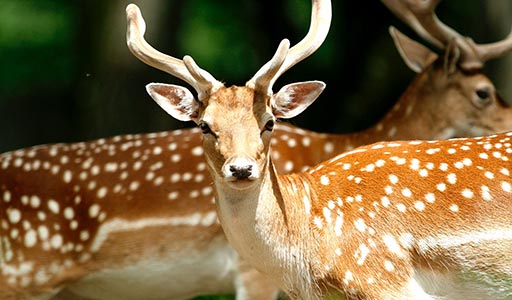Deer Control
Do you need to get rid of Deer? We can help!

Deer Removal Strategies
If you have noticed damage done to your bushes and shrubs, it is time to call the experts of Trutech in to conduct a deer removal from your property. All of our specialists are licensed to perform humane deer removal services that will alleviate the pain caused by these creatures on your property. If you have spotted a deer carcass near your home, do not worry. Our experts can also take care of that using the necessary precautions and tools.
Do not wait until deer have destroyed your yard to call in a team of experts from Trutech. The sooner you call Trutech, the sooner you can find a solution for all of your dear control needs. Our team loves animals, big or large, and wants to make sure that they do not cause you or your property any harm. So call in our team of experts at Trutech today!
Hear what a Deer sounds like
Deer Problem

Signs a Deer is on Your Property
The deer population across many parts of the United States has been growing consistently for decades. Deer are beautiful four-legged creatures that subsist entirely off of plants and vegetation that they pick off of trees and bushes in the wild. Frequently, when deer are fed in residential areas, it increases the likelihood that they will return to these areas in search of food. Entering into residential neighborhoods can result in deer getting hit by cars or trucks. Deer can cause hundreds of dollars worth of damage to your landscaping and plants. And, since they are present in most of the United States, the chances that you have encountered deer on your property is high, especially if you reside in a wooded area.

Dangers of Deer Infestation
Farms, orchards, nurseries, and home gardens endure the most damage from deer activities. Where large deer populations arise alongside urban areas, dangerous automobile accidents occur when the animals leap in front of moving cars while attempting to cross roads. Additionally, deer populations can grow to unsustainable numbers and strip an area completely bare of food, causing starvation for other animals in the local ecosystem. White-tailed deer are also prime carriers of deer ticks, which spread Lyme disease to humans.
Humane Deer Removal & Control Strategies

Entry into property
Deer usually avoid entering houses, but are commonly known to enter yards, farms, parks, and other open areas. Enticed by the lack of predators and strict hunting regulations, deer move into residential neighborhoods to graze in backyards throughout the early morning or late evening hours. Although the creatures can be timid and skittish, they become accustomed to people once they realize there is no danger.

Trapping & Removal
Trapping and removal are not effective deer repellents, since the animals are known to range for hundreds of acres and may return to capture sites in time. Property owners should turn to professional wildlife control experts for assistance with handling nuisance deer issues. Trutech personnel can help mitigate unwanted deer infestations in yards and gardens.

Prevention & Exclusion
Although regulated hunting is the primary method of deer control, most suburban areas do not allow hunting to take place. Large deer fences can be costly to erect but often prove excellent deer repellents. Residents of suburban areas can have pet dogs patrol the yard, plant deer-resistant ornamental plants, or spray plants with hot sauce as alternative means of keeping deer away from lawns.
Frequently Asked Questions
Since they eat a variety of plants and crops, deer are dangerous for gardens and landscaping. They also stunt tree growth by stripping bark from trunks and branches. In addition, deer herds near homes are a problem because of the ticks they carry. In areas overpopulated with deer, residents have a higher risk of contracting Lyme disease.
Deer accidents involving vehicles are common as well. Thousands of people run into deer while crossing busy roads each year, and many of those collisions result in injury or death. Even deer-related accidents that don’t end with physical harm may cost drivers hundreds of dollars in damages.
Deer frequently enter residential lawns in search of food, and property owners whose homes border wooded areas, thickets, and grasslands regularly find deer in the backyard. The pests eat a variety of vegetation, including grasses, flowering plants, fruits, nuts, ornamental trees, and garden vegetables.
Deer generally stay close to their home range to find mates, breed, and raise their young. Backyards tend to be either part of that range or convenient areas to rest for migrating populations.
Overwhelming populations of white-tailed deer live in nearly every state of the country. These pests like to congregate on farmland, the edges of forested areas, and residential lawns, as these sites all offer consistent sources of food. Though it’s rare, deer will occasionally wander into garages while foraging for meals. Since they’re relatively large animals, the pests are only able to enter garages when the doors have been left open.
Most diseases deer contract are only harmful to the animals themselves. These include hemorrhagic disease and chronic wasting disease. While detrimental to deer populations, they don’t spread to humans. However, deer also carry parasites such as nemotodes, lungworms, and ticks. The first two pose no direct threat to people or pets, but ticks can transmit a long list of illnesses to humans, including Lyme disease. Symptoms start out similar to the flu but can result in death without treatment.
Deer only end up in homes when confused or by accident. They wander onto residential lawns in search of their favorite foods, like fruits, nuts, garden vegetables, and shrubs. While foraging for food, deer might see their own reflection in the windows or glass doors of homes. Since the pests are inquisitive, this leads them to approach houses and even crash through the glass. Additionally, open doors may invite curious deer into homes.
NATURAL DEER REPELLENT
There are many types of natural deer repellents that can reduce damage. Household items like hot sauce and diluted soap are popular because of their bad smell and taste. Deer repellent plants may also prevent grazing. Mint, lavender, and garlic have strong scents that deter the pests.
CHEMICAL DEER REPELLENT
Homeowners can also apply chemical deer deterrents to plants or the surrounding area. These products have unpleasant smells and tastes to keep the pests away from lawns. Many chemical deer repellents include ingredients such as:
- Rotten egg solids – This material is effective due to its foul scent.
- Coyote urine – Deer associate this odor with predators.
- Garlic and pepper – In concentrated amounts, deer will avoid these unpleasant tastes.
While chemicals and natural deer repellents seem like easy fixes, they can be costly and residents must reapply them regularly, especially after rain.


